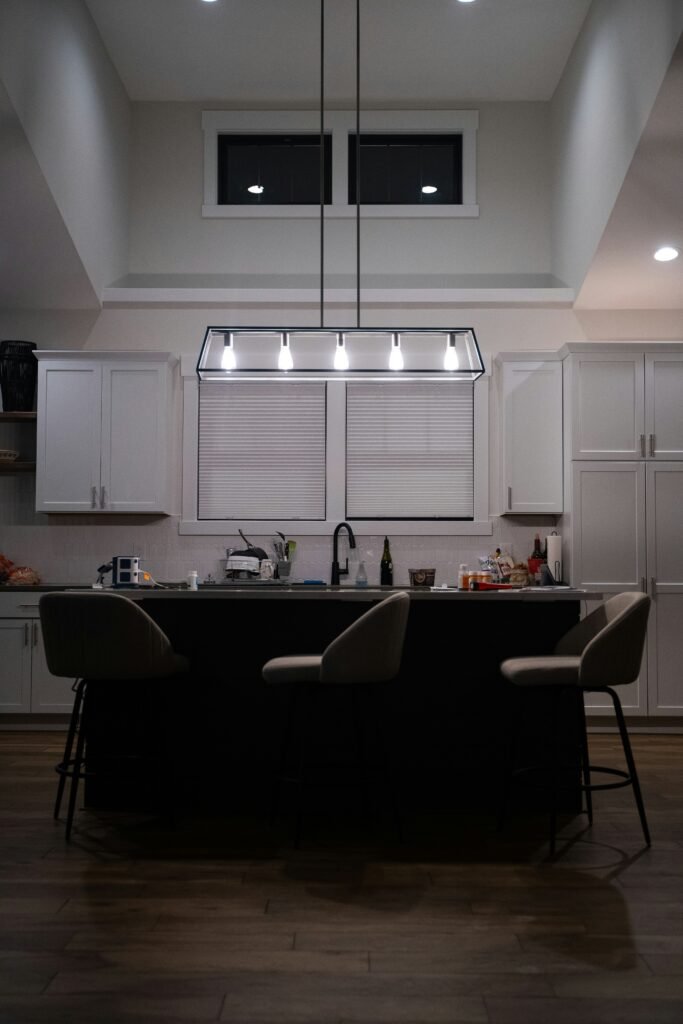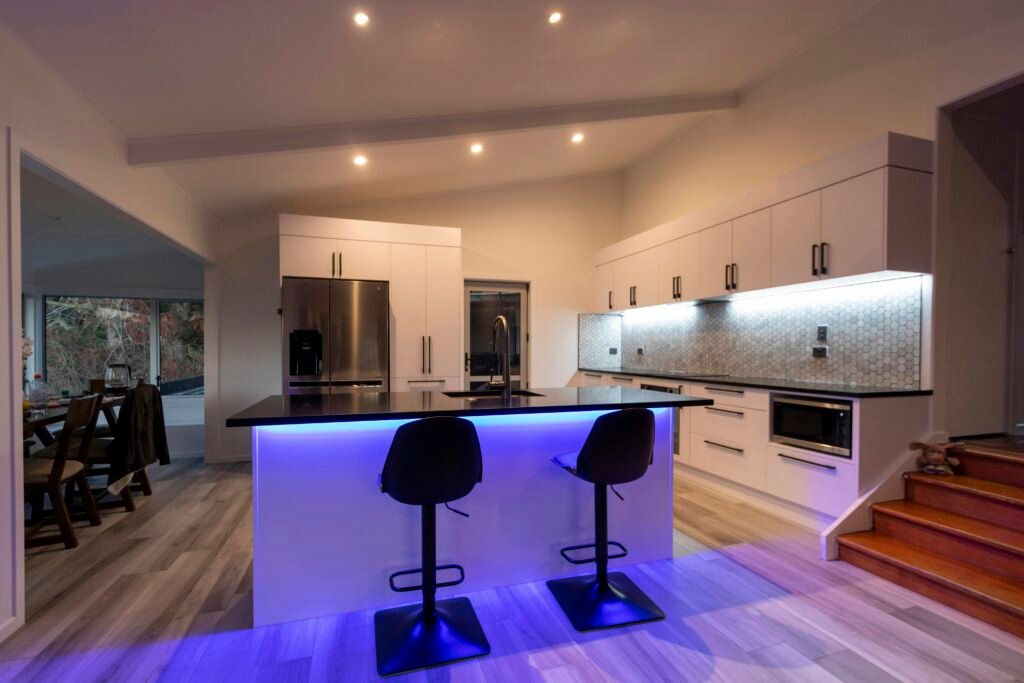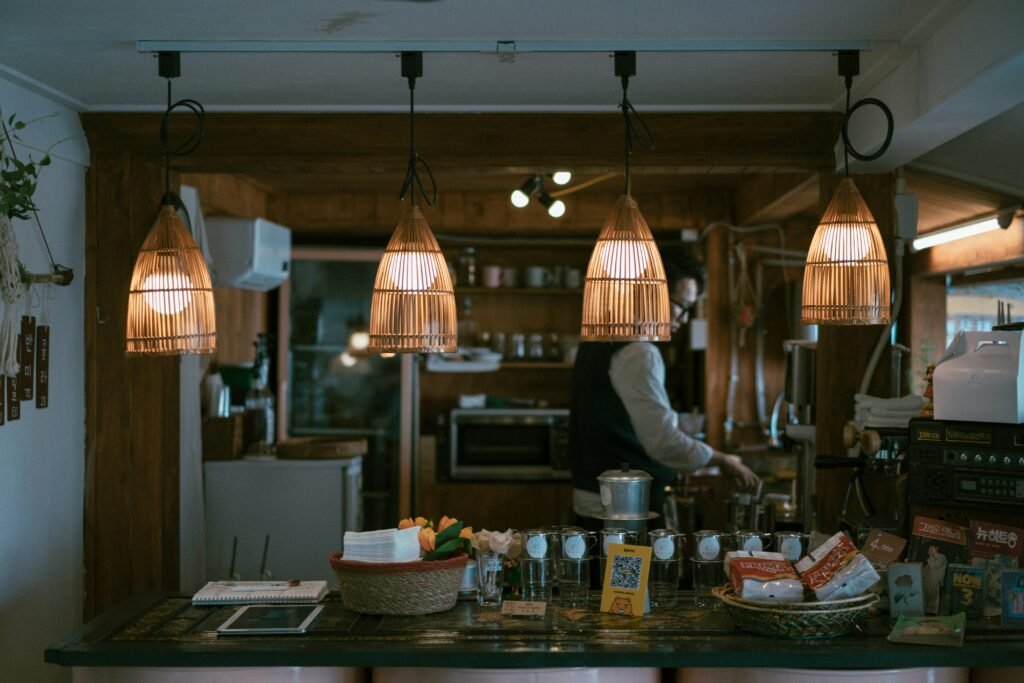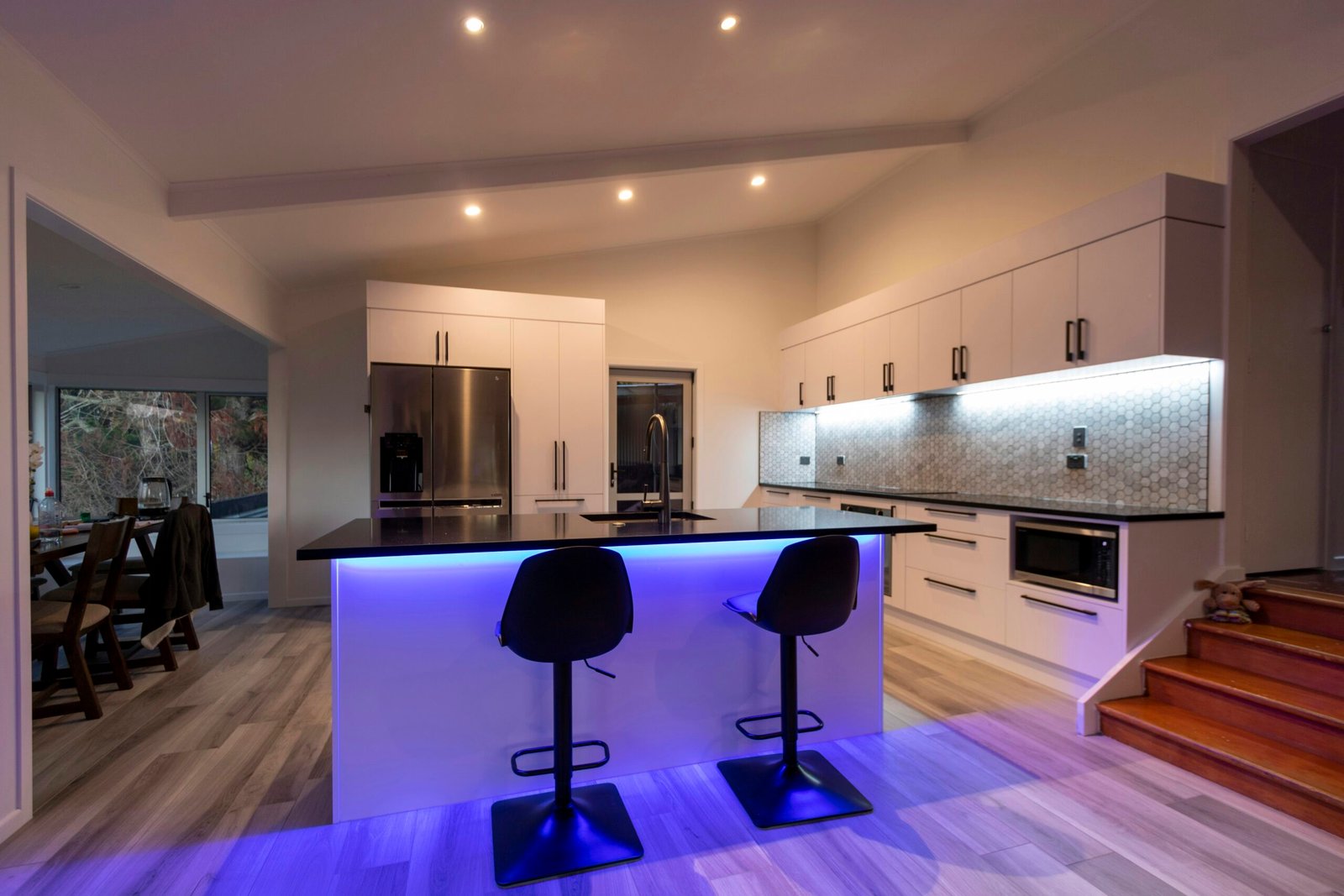Are you tired of your dimly lit kitchen? Looking to brighten up your space while also saving on energy costs? Look no further! In this article, we will explore a variety of illuminating options that will transform your kitchen into a well-lit haven. From LED lights to under cabinet lighting, we’ll guide you through the world of energy-saving lighting solutions, helping you create a warm and inviting atmosphere in your kitchen without breaking the bank. Get ready to illuminate your kitchen and bring a whole new vibe to your cooking experience!
Benefits of Energy-Efficient Kitchen Lighting
When it comes to lighting up your kitchen, choosing energy-efficient options can bring a multitude of benefits. Let’s take a closer look at some of the advantages of energy-efficient kitchen lighting:
Reduced energy consumption
One of the key benefits of energy-efficient lighting in your kitchen is the reduction in energy consumption. Traditional incandescent bulbs consume a significant amount of energy, often resulting in high electricity bills. By opting for energy-efficient lighting solutions, such as LED or CFL bulbs, you can significantly lower your energy consumption and contribute to a greener environment.
Lower electricity bills
Reducing your energy consumption directly translates to lower electricity bills. Energy-efficient lighting fixtures use less electricity to produce the same amount of light, resulting in substantial savings over time. By making this small change, you can enjoy a well-illuminated kitchen while also saving money on your monthly energy expenses.
Environmentally friendly
By investing in energy-efficient kitchen lighting, you are making a positive impact on the environment. Energy-efficient bulbs, such as LEDs and CFLs, require less energy to function, which means fewer greenhouse gas emissions. Choosing environmentally friendly lighting options helps in conserving natural resources and reducing your carbon footprint.
Enhanced lighting quality
Energy-efficient lighting options provide superior lighting quality compared to traditional incandescent bulbs. LED and CFL bulbs emit light with a higher Color Rendering Index (CRI), which accurately replicates the colors of objects in your kitchen. This enhanced lighting quality ensures that you can clearly see the true colors of your food, helping with meal preparation and presentation.
Extended lifespan of bulbs
When it comes to energy-efficient lighting, longevity is a key advantage. LED bulbs, for example, have an exceptionally long lifespan, often lasting 10-20 times longer than incandescent bulbs. By choosing energy-efficient lighting fixtures, you will save not only on energy costs but also on the frequent replacement of bulbs, resulting in further savings in the long run.
Types of Energy-Efficient Lighting Fixtures
Now that we’ve explored the benefits of energy-efficient kitchen lighting, let’s delve into the various types of lighting fixtures that can help you achieve an efficient and well-lit kitchen:
LED (Light-Emitting Diode) bulbs
LED bulbs are the epitome of energy efficiency. Not only do they consume less energy than traditional bulbs, but they also have an exceptionally long lifespan. LED bulbs emit a bright, uniform light, making them ideal for general and task lighting in the kitchen. They are available in various color temperatures and can be dimmed to create the desired ambiance.
CFL (Compact Fluorescent Lamp) bulbs
CFL bulbs are another popular energy-efficient lighting solution. While they may take a few seconds to reach their full brightness, CFL bulbs consume considerably less energy than incandescent bulbs. CFLs are available in different color temperatures and can be used for both general and task lighting in the kitchen. It’s important to properly dispose of CFL bulbs, as they contain a small amount of mercury.
Halogen bulbs
Halogen bulbs are a type of incandescent bulb that offers improved energy efficiency. They are known for their bright, white light and can be used for various lighting purposes in the kitchen. While halogen bulbs are more efficient than traditional incandescent bulbs, they still consume more energy and have a shorter lifespan compared to LED or CFL bulbs.
Energy-saving incandescent bulbs
Energy-saving incandescent bulbs are a more efficient version of traditional incandescent bulbs. They use halogen technology to provide a warm, inviting light while consuming less energy. While energy-saving incandescent bulbs are more efficient than standard incandescent bulbs, they still consume more energy than LED or CFL bulbs.

This image is property of images.unsplash.com.
Choosing the Right Color Temperature
The color temperature of your kitchen lighting plays a crucial role in creating the desired ambiance and enhancing the overall aesthetics of the space. Here are some factors to consider when selecting the right color temperature for your kitchen:
Understanding the Kelvin scale
Color temperature is measured on the Kelvin (K) scale. Lower Kelvin temperatures produce warm light, while higher Kelvin temperatures produce cool light. By understanding the Kelvin scale, you can choose the right color temperature for your kitchen lighting.
Warm white (2700K-3000K)
Warm white lighting creates a cozy and inviting atmosphere in the kitchen. This color temperature is ideal for areas where you want to create a warm and comforting ambiance, such as dining areas or breakfast nooks.
Cool white (3500K-4100K)
Cool white lighting provides a bright and energetic feel to your kitchen. It is suitable for areas where you need to focus and perform tasks efficiently, such as food preparation areas or workstations.
Daylight white (5000K-6500K)
Daylight white lighting replicates the color temperature of natural daylight. This color temperature is perfect for kitchens with minimal access to natural light, as it creates a bright and vibrant atmosphere, similar to being outdoors during the day.
Considering the kitchen’s color scheme
When choosing the color temperature for your kitchen lighting, it’s essential to consider the color scheme of your kitchen. Warm color temperatures complement warm-toned kitchens, while cool color temperatures work well with cool-toned kitchens. Harmonizing the color temperature with the overall color scheme of your kitchen will create a cohesive and visually appealing space.
Strategic Placement of Lighting Fixtures
To achieve a well-lit kitchen, it’s important to strategically place different types of lighting fixtures. By combining various lighting techniques, you can enhance the functionality and aesthetics of your kitchen. Let’s explore the different types of lighting fixtures and their appropriate placement:
General lighting
General lighting provides overall illumination to the entire kitchen. It is typically achieved through overhead lighting fixtures, such as ceiling-mounted lights or recessed lighting. Placing general lighting fixtures in the center of the kitchen ensures that the space is well-lit and eliminates any dark corners.
Task lighting
Task lighting is essential for specific areas where detailed tasks are performed, such as food preparation areas or countertops. Installing under-cabinet lighting or adjustable track lighting above workstations can provide ample illumination for these tasks. Task lighting should be positioned to minimize shadows and glare, ensuring optimal visibility and safety while working in the kitchen.
Accent lighting
Accent lighting adds a touch of elegance and highlights specific features in your kitchen. It can be used to showcase architectural elements, artwork, or decorative items. Installing spotlights or wall sconces can create a dramatic effect and draw attention to these focal points.
Under-cabinet lighting
Under-cabinet lighting serves both functional and aesthetic purposes. It illuminates the workspace on the countertop and adds a warm, inviting glow to your kitchen. LED strip lights or puck lights are popular choices for under-cabinet lighting. They can be easily installed and offer a wide range of color options to suit your kitchen’s design.
Overhead lighting
Overhead lighting fixtures, such as pendant lights or chandeliers, can add a touch of style and sophistication to your kitchen. They are typically installed above islands or dining areas and serve as statement pieces that enhance the overall ambiance of the space.
Avoiding shadows and glare
When placing lighting fixtures in your kitchen, it’s important to consider the angles and potential shadows or glare they may create. Placing lights directly above workstations or using adjustable fixtures can help minimize shadows and provide sufficient illumination for tasks. Using fixtures with diffusers or adding a layer of indirect lighting can reduce glare and create a softer, more comfortable atmosphere.

This image is property of images.unsplash.com.
Utilizing Natural Light
In addition to energy-efficient lighting fixtures, utilizing natural light can significantly enhance the overall lighting of your kitchen. Here are some tips to maximize the use of natural light in your kitchen:
Maximizing window openings
Maximizing the size and number of windows in your kitchen can allow ample natural light to flood the space. Consider enlarging existing windows or adding new ones to make the most of natural light.
Using skylights or sun tunnels
If your kitchen doesn’t have sufficient window openings, skylights or sun tunnels can be excellent alternatives. These solutions bring natural light into the kitchen from above, creating a bright and airy atmosphere.
Installing light curtains or blinds
To control the amount of natural light coming into your kitchen, consider installing light curtains or blinds. These can be adjusted to filter the sunlight and reduce glare, while still allowing plenty of natural light to enter the space.
Optimizing kitchen layout for natural light
When designing or renovating your kitchen, consider the placement of windows and how they align with the kitchen’s layout. Position workstations or main activity areas near windows to maximize the benefits of natural light. This will not only provide well-lit workspaces but also create a pleasant and inviting environment.
Dimmer Switches and Lighting Controls
Incorporating dimmer switches and lighting controls into your kitchen lighting setup offers flexibility and convenience. Here’s how you can benefit from these features:
Benefits of dimmable lights
Dimmable lights allow you to adjust the intensity of illumination according to your needs. This feature is especially useful in the kitchen, as it allows you to create different moods and adapt the lighting to different activities, such as cooking, dining, or entertaining.
Installing dimmer switches
Installing dimmer switches is a straightforward process that can be done by replacing your existing light switches. Dimmer switches provide a range of adjustments, giving you full control over the brightness of your kitchen lighting.
Remote control options
For added convenience, consider installing lighting fixtures that can be controlled remotely. Remote control options allow you to adjust the lighting from anywhere in the kitchen, eliminating the need to manually operate the switches.
Integrating lighting controls with smart home systems
For a fully automated lighting experience, integrate your lighting controls with a smart home system. Smart home systems allow you to program lighting scenes, sync them with other smart devices, and control your kitchen lighting using voice commands or smartphone apps. This integration offers flexibility and energy-saving opportunities, making your kitchen lighting more efficient and convenient.

This image is property of images.unsplash.com.
Maintenance and Cleaning Tips
Proper maintenance and cleaning of your kitchen lighting fixtures are essential to ensure optimal performance and longevity. Here are some tips to keep your lighting in top condition:
Regularly dusting fixtures
Dust and debris can accumulate on your lighting fixtures over time, affecting their performance and reducing the amount of light emitted. Regularly dusting your fixtures with a soft cloth or a feather duster can help maintain their cleanliness and efficiency.
Replacing bulbs when needed
To maintain optimal lighting quality, replace bulbs as soon as they start to dim or flicker. Dim bulbs not only provide less light but also consume more energy. Make sure to use the correct replacement bulbs that are compatible with your fixtures.
Cleaning fixtures and shades
In addition to dusting, periodically clean your lighting fixtures and shades to remove any stubborn dirt or stains. Use a mild soap solution or a glass cleaner, and avoid using abrasive materials that can scratch the surfaces. Make sure to turn off the power before cleaning any electrical components.
Proper disposal of old bulbs
When disposing of old bulbs, it’s important to handle them with care and follow proper disposal guidelines. CFL bulbs contain a small amount of mercury, which can be harmful to the environment if not disposed of correctly. Check your local regulations for the proper disposal methods and recycling options for different types of bulbs.
Energy-Efficient Lighting Retrofitting
If you’re looking to upgrade your existing kitchen lighting to energy-efficient solutions, retrofitting is a viable option. Here are some considerations for retrofitting your kitchen lighting:
Assessing current lighting setup
Start by assessing your current lighting setup and identifying areas that need improvement. Consider the type of bulbs, fixtures, and lighting controls you currently have and how they can be replaced or upgraded to energy-efficient alternatives.
Upgrading to energy-efficient fixtures
Replace outdated fixtures with energy-efficient options like LED or CFL fixtures. Retrofit kits are available to easily convert existing fixtures to accommodate these energy-efficient bulbs. This upgrade will not only reduce energy consumption but also enhance the overall lighting quality in your kitchen.
Considering lighting control systems
Alongside upgrading fixtures, consider incorporating lighting control systems into your retrofitting project. Installing dimmer switches, occupancy sensors, or timers can further enhance the energy efficiency and convenience of your kitchen lighting setup.
Working with a professional electrician
For complex retrofitting projects or if you’re not familiar with electrical work, it’s advisable to seek the assistance of a professional electrician. They can assess your current wiring, recommend appropriate lighting products, and ensure that the retrofitting is done safely and efficiently.
Other Energy-Saving Kitchen Lighting Ideas
In addition to the aforementioned tips, here are a few other energy-saving ideas to consider for your kitchen lighting:
Using motion sensor lights
Installing motion sensor lights in your kitchen can save energy by automatically turning on and off when someone enters or leaves the room. This eliminates the need to remember to switch off the lights and ensures that energy is not wasted when the room is unoccupied.
Installing occupancy sensors
Similar to motion sensor lights, occupancy sensors detect the presence of people in a room and adjust the lighting accordingly. They can be installed in different areas of your kitchen, such as cabinets or drawers, ensuring that lights are only turned on when needed.
Using task lighting instead of overhead lights
For specific tasks or areas in your kitchen, opt for task lighting instead of relying solely on overhead lights. Task lighting provides focused illumination where it’s needed most, reducing energy waste by illuminating only the required areas.
Optimizing lighting zones
Consider dividing your kitchen into lighting zones and having separate controls for each zone. This allows you to only illuminate the necessary areas, depending on the activities being carried out. By optimizing lighting zones, you can minimize energy consumption and tailor the lighting to specific needs.
Conclusion
Choosing energy-efficient lighting solutions for your kitchen brings numerous benefits, ranging from reduced energy consumption and lower electricity bills to creating an environmentally friendly and well-lit space. By selecting the right lighting fixtures, understanding color temperatures, strategically placing lighting fixtures, utilizing natural light, incorporating dimmer switches and lighting controls, properly maintaining your lighting, and considering energy-saving ideas, you can transform your kitchen into a more efficient and aesthetically pleasing environment. With the combination of energy efficiency, functionality, and style, your kitchen will become an illuminated haven for cooking, dining, and creating memorable moments with loved ones.
